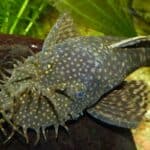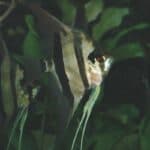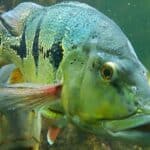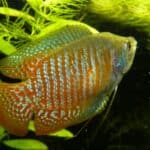If you’re a fan of big aquariums, you’ve probably considered getting a Wolf Cichlid at some point.
Keeping a Wolf Cichlid (Parachromis dovii) can be a lot of work, but it’s worth it if you want to experience the thrill of owning a big fish.
Also known as a “monster fish,” this species is very hardy and can live in a wide range of extreme water conditions. However, they can get quite large in captivity, requiring enough room in your tank!
And like all other Parachromis fish, the Wolf Cichlid is aggressive towards anything else inside its tank.
So, are you still up for the challenge? If yes, read this guide until the end.
Species Summary
Native to the rivers and streams of Central America, the Wolf Cichlid is a large, predatory fish that is not for the faint of heart.
Growing up to two feet in length, these fish can wreak havoc in a community tank and are best suited for experienced aquarists who are prepared to provide them with the ample space and proper care they require. Despite their intimidating size and reputation, Wolf Cichlids are relatively easy to spawn in captivity, making them a popular choice among breeders.
Wolf Cichlid Care Guide
Wolf Cichlids can make a great addition to a show tank. But before you go out and buy one of these fish, you must learn how to care for them properly. So in this section of the guide, we’ll give you tips on caring for your new Wolf Cichlid.
Tank Size
As you can imagine, these fish need a lot of space to swim and thrive. In fact, they should be kept in large aquariums that are at least 132 gallons. The dimensions of the aquarium should also be 80″ x 20″ x 20″. This will give the fish plenty of room to move around and stay healthy.
Of course, the bigger the aquarium, the better. So if you have the space, go for it! Your Wolf Cichlid will thank you for it.
Tank Mates
The Wolf Cichlid is a very aggressive species of fish that is not well suited for life in a community tank. They will attack and eat smaller fish.
Some suitable tank mates for the Wolf Cichlid include other Parachromis, Red Devil, Flowerhorn, Oscar, and Midas Cichlids.
Same Species Tanks
One of the most important things to know about the Wolf Cichlid is that they should be kept in a monospecies tank. This means that they should be the only fish in the tank. They are often kept as a single species in biotope-type aquariums, mimicking the species’ original location.
Water Parameters
They are susceptible to water pollution and acidic water conditions. Therefore, maintaining good water quality in their aquarium and keeping the pH level within the ideal range is essential.
The ideal temperature for keeping Wolf Cichlids is 75 to 89 degrees Fahrenheit. The ideal pH range is between 7.0 and 8.0, and the hardness should be between 15 and 20 degrees dH.
What to Put in Their Tank
With some preparation, you can create a perfect home for your Wolf Cichlid and enjoy watching them thrive.
Aquarium heaters and filtration systems are essential for all aquatic animals, and the Wolf Cichlid is no exception. Make sure your filtration system is well-sized and creates a moderate flow; these fish enjoy a well-lit aquarium but also need plenty of hiding places.
Furthermore, the aquarium’s decoration is not critical to guaranteeing success in maintaining the species. But providing territories and hiding places for the animals and adding rocks and driftwood makes for a more natural environment and helps form different caves.
They are well-known diggers, so make sure to use a soft substrate with no edges and angles that could hurt the fish’s mouth.
Common Diseases
They are incredibly disease-resistant. This is thanks to their strong immune system and ability to adapt to different water conditions. However, like all cichlids, they can be susceptible to acidosis and inadequate water quality. This is why it’s so important to keep the quality of your tank water and diet in optimal condition.
Food and Diet
As you probably already know, Cichlids are piscivores – which means that their natural diet consists mainly of fish. However, they also feed on crustaceans and insects.
One thing to remember is that if you’re getting a Wolf Cichlid of wild origin, they may have some difficulty adjusting to a diet of commercial feed. That’s why it’s essential to supplement their diet with live, fresh or frozen foods like fish and shrimp. This will help them to look more vivid, and their behavior will be closer to what you would see in the wild.
Another vital thing to remember is that Wolf Cichlids are always hungry! So, you’ll need to set a regular feeding schedule and ensure you’re giving them enough food to eat. A good rule of thumb is to provide them with an amount of food they can consume in a few minutes.
Lifespan
A Wolf Cichlid can have a lifespan of up to 10 years in an aquarium. This is double the average lifespan of a wild Wolf Cichlid. The main reason for this difference is that, in captivity, these fish are protected from predators and diseases. They also have a more stable environment with consistent water parameters.
Appearance
These fish are known for their predatory nature, having a robust and muscular body that is aerodynamic. In addition, they have large mouths and eyes, and their lateral line is discontinuous, forming a pattern that resembles dotted or blurred lines.
The base color of their body is a silvery iridescence, and they have reticulate spots. Their fins can exhibit a beautiful greenish glow, and their body’s lower half is brighter than the upper half.
Both males and females can have reddish or green tones on their heads and fins. However, the male Wolf Cichlid is more colorful than the female.
As for juveniles, they are silver in color with a horizontal black stripe that runs along their body.
Size
The Wolf Cichlid is a huge fish – it can grow up to 2.5 feet long!
Behavior and Temperament
This massive fish is one of the most aggressive freshwater fish out there – and it’s not for beginner fish keepers.
The Wolf Cichlid’s aggression is mainly directed toward other fish similar in shape and color. They are also known to be aggressive towards their species, so it’s best to keep them alone or with one male and one female. The females, however, can be relatively peaceful, except when mating.
If you’re thinking of getting one of these fish, you should only do so if you are prepared to keep them in a single-species aquarium.
Breeding
The Wolf Cichlid is an oviparous species, which means that both parents take care of the fry (baby fish). They reach sexual maturity at around 15 months and 8 inches.
Spawning usually occurs in the substrate, and both parents will take care of the fry. The female can lay anywhere from 1000 to 1500 eggs. After laying the eggs, the fry will hatch within five days and be able to swim freely within three days – all under parental supervision, of course!
When breeding this species, it’s essential to pay attention to the formation of pairs. The male can become quite aggressive and attack the female if not adequately monitored. Once the fry has hatched, it’s also a good idea to separate them by size. The larger fry tends to eat the smaller ones if they’re not kept separate.
Gender Differences: Male vs Female
When it comes to Wolf Cichlids, there are some pretty clear gender differences. For starters, mature males are more colorful, while adult females are more yellow. Additionally, males typically have solid black lateral lines, while females have “broken” lines along their bodies.
These differences are likely because males need to be more colorful to attract mates. After all, they’re the ones who need to do most of the work regarding reproducing. Meanwhile, females don’t need to be flashy since they don’t have to worry about attracting a mate.
Wolf Cichlid Fun Facts
● Its scientific name Parachromis comes from the Greek, para = the side of + chromis = perch, a kind of fish.
● The species is distributed along the Atlantic slope, from the Aguan River (Honduras) to the Moín River (Costa Rica); Pacific slope from the Yeguare River (Honduras) to the Bebedero River (Costa Rica).
● This species is locally considered a top predator and essential for local commercial fishing and is widely sought after in sport fishing. The Wolf Cichlid is a beautiful, predatory fish that genuinely captures the spirit and majesty of its namesake!
Closing Thoughts
If you’re willing to take on the challenge of keeping a Wolf Cichlid, they can make a great addition to your aquarium. Just be sure to do your research and be prepared for their aggressive nature. With proper care, they can be a fascinating and long-lived addition to your home.
References.
Bussing, W.A., 1998. Peces de las aguas continentales de Costa Rica [Freshwater fishes of Costa Rica]. 2nd Ed. San José Costa Rica: Editorial de la Universidad de Costa Rica.
Kullander, S.O., 2003. Cichlidae (Cichlids). p. 605-654. In R.E. Reis, S.O. Kullander and C.J. Ferraris, Jr. (eds.) Checklist of the Freshwater Fishes of South and Central America. Porto Alegre: EDIPUCRS, Brasil.
Romero, P., 2002. An etymological dictionary of taxonomy. Madrid, unpublished.
IGFA, 2001. Database of IGFA angling records until 2001. IGFA, Fort Lauderdale, USA.








